Unit 12: Membrane Transport
1/56
There's no tags or description
Looks like no tags are added yet.
Name | Mastery | Learn | Test | Matching | Spaced |
|---|
No study sessions yet.
57 Terms
Membrane transport can be classified into…
passive and active transport
What is passive transport?
The transported molecules/ions travel down their concentration gradient
Can be non-mediated (AKA simple diffusion) or protein-mediated (AKA facilitated diffusion)
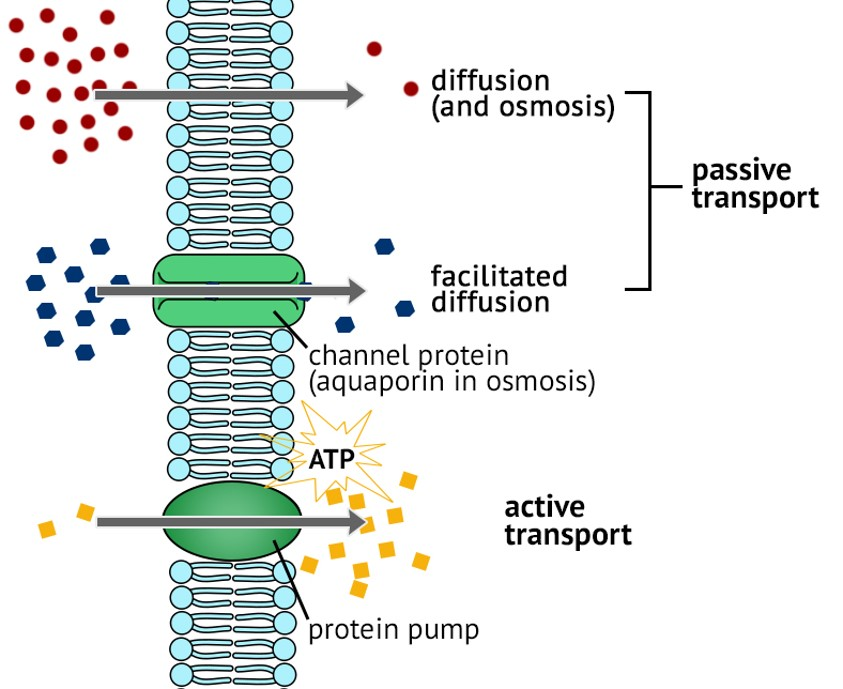
What is active transport?
The transported molecules/ions migrate against the concentration gradient → requires some input of energy to pump them across the membrane
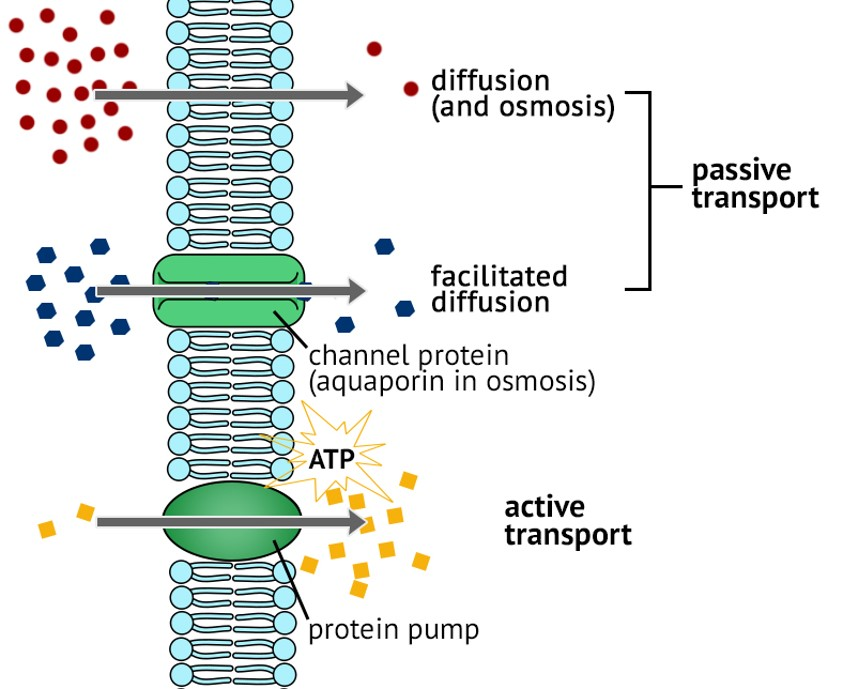
The rate of simple diffusion depends on…
The magnitude of the substance concentration gradient and its solubility in the membranes nonpolar core
The hydrophobicity, charge and size of the molecule
What kind of molecules will diffuse more readily across the membrane’s lipid bilayer?
Non-polar
What type of passive transport requires special proteins or passive transporters?
Facilitated (mediated) diffusion
In facilitated (mediated) diffusion, what do passive transporters do and not do?
They do not shift the equilibrium of the transport process, but simply facilitate the rate of diffusion by creating a favorable passage
Illustrate the difference between mediated and simple diffusion with the example of glucose transport.
Glucose can passively diffuse at a slow rate across the membrane unless phosphorylated (via glycolysis)
The rate of diffusion can be accelerated if glucose crosses the membrane through a special transporter, such as GLUT1.
GLUT1 facilitates glucose transport across the plasma membrane of mammalian cells.
Glucose transporter opening appears on the extracellular side of the cell
Glucose binds to GLUT1 outside of the cell → changes conformation of the transporter
Glucose transporter opening appears on the intracellular side
The bound glucose molecule is released inside the cell.
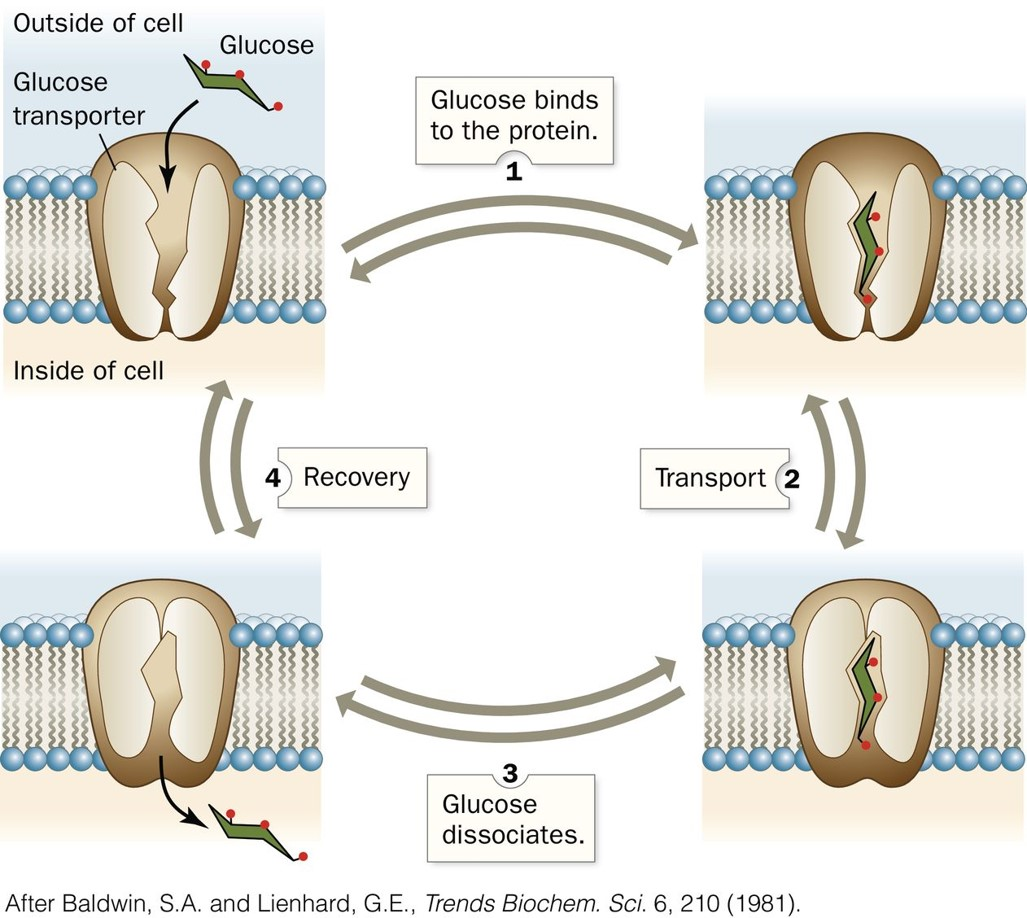
What special channel proteins facilitate water transport?
Aquaporins
There are 13 different aquaporins in mammals. What is their overall function?
They mediate transmembrane movement of water in the kidney, salivary glands, and lacrimal glands
Aquaporins not only accelerate diffusion of water across cell membranes, but they also…
Enable high selectivity (up to 3 × 10^9 molecules/sec) - they allow passage of water molecules but do not allow hydronium ions to go through
What is an example of an aquaporin and its structure?
AQP1
Homotetramer - each monomer acts as a water channel
The transmembrane domain of each monomer is composed of 6 α-helices
There is an elongated central pore with the narrowest diameter of 0.28 nm → corresponds to the size of a water molecule
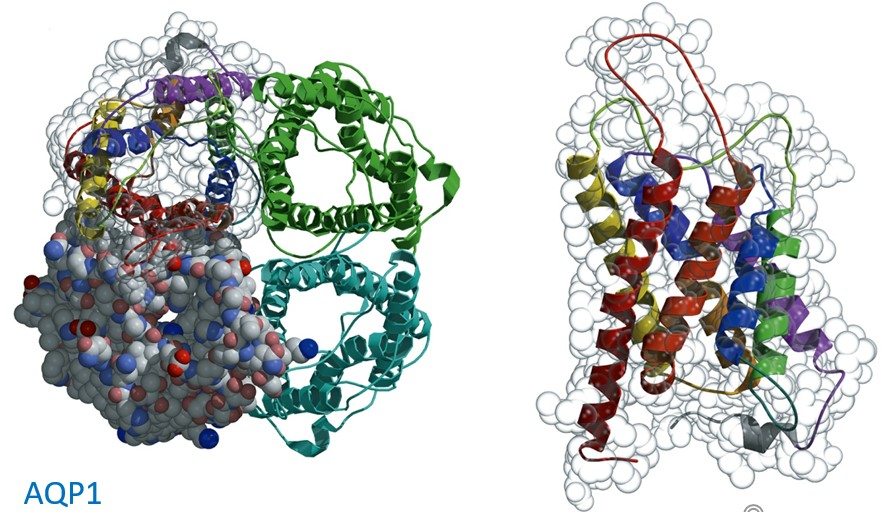
Explain the mechanism for high selectivity of aquaporins.
Two Asn molecules in the central opening can form 2 hydrogen bonds with water molecules
Hydronium ions cannot pass through because they can only form 1 hydrogen bond
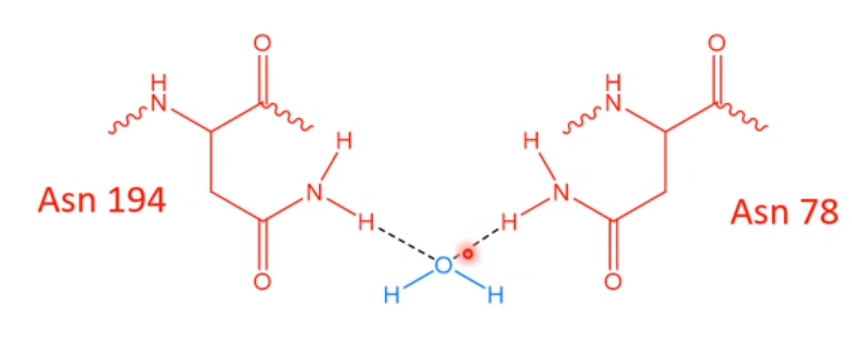
What are porins?
Transmembrane proteins that form pores through which biological molecules can go through to cross biological membranes via facilitated diffusion
What is the general structure of porins?
They often have a ß-barrel structural motif for their transmembrane domains
Where are porins found and what is their function?
In the outer membrane of gram-negative bacteria
In the mitochondrial membrane of eukaryotes
They allow flow of nutrients into cells, while metabolic waste and toxins are translocated out of the cells
Explain OmpF porin from Escherichia coli and its structure.
The length of the channel is ~5.5 nm (same as the thickness of the lipid bilayer)
The pore diameter is ~0.7 nm → only molecules smaller than 600 Da can go through
Explain maltoporin from E. coli and the presence of greasy slide.
Facilitates diffusion of maltodextrin (products of starch degradation)
Consists of a ß-barrel motif composed from 18 antiparallel ß-strands
Greasy slide
6 contiguous aromatic amino acid residues with their side chains are arranged in a left-handed helix
Continuous exchange of hydrogen bonds as maltodextrin moves through the channel
The presence of a Tyr residue on the opposite side of the channel from the greasy slide enable selective entering of the ligands from the required shape of the substrate
What are ionophores?
Passive transporters that allow passage of ions across biological membranes
Can be subdivided into carrier ionophores and channel-forming ionophores
What are carrier ionophores?
They include lipid-soluble ions → shielding their charge and increasing permeability of the membrane of the membrane for ions
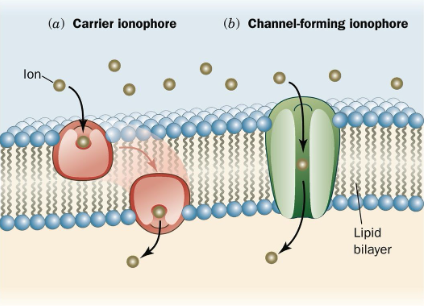
What are channel-forming ionophores?
Proteins that span the membrane and form pores through which ions can diffuse
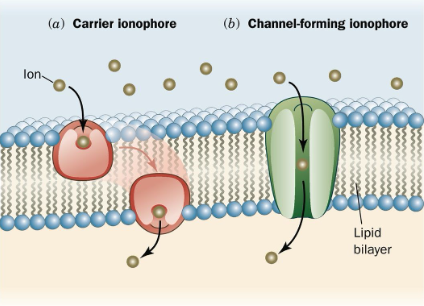
What is an example of carrier ionophores?
Valinomycin
A macrocyclic molecule consisting of alternating L-Val, D-hydroxyisovaleric acid, D-Val, and L-lactic acid residues connected to each other via peptide and ester binds
Specifically binds potassium ions over sodium ions
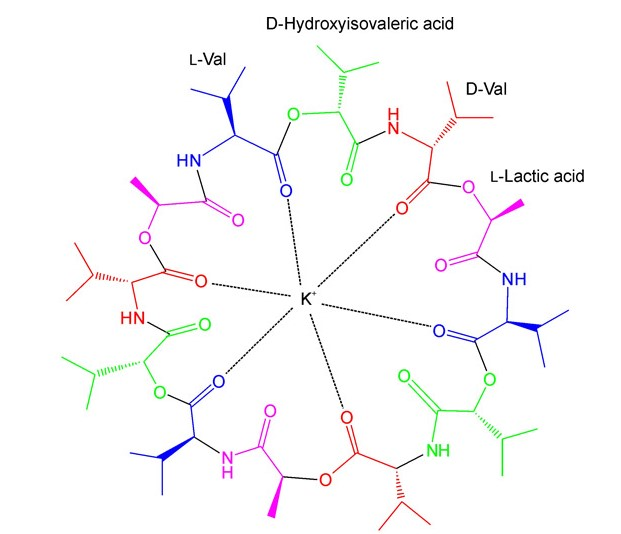
Why does valinomycin favor potassium ions over sodium ions?
The K+ radius minimizes steric strain and potential for degrees of rotation
What is an example of a channel-forming ionophore?
Potassium channels
Passive channel-forming protein transporters that specifically facilitate diffusion of K+ through the membrane
Homotetramer → each subunit is composed of two α-helices connected via a short loop
Inner helices of the four subunits form a channel that tapers in width from the intracellular side (~0.6 nm) to the extracellular side (~0.3 nm)
The middle contains a 1-nm wide cavity that is lined with hydrophobic amino acid residues
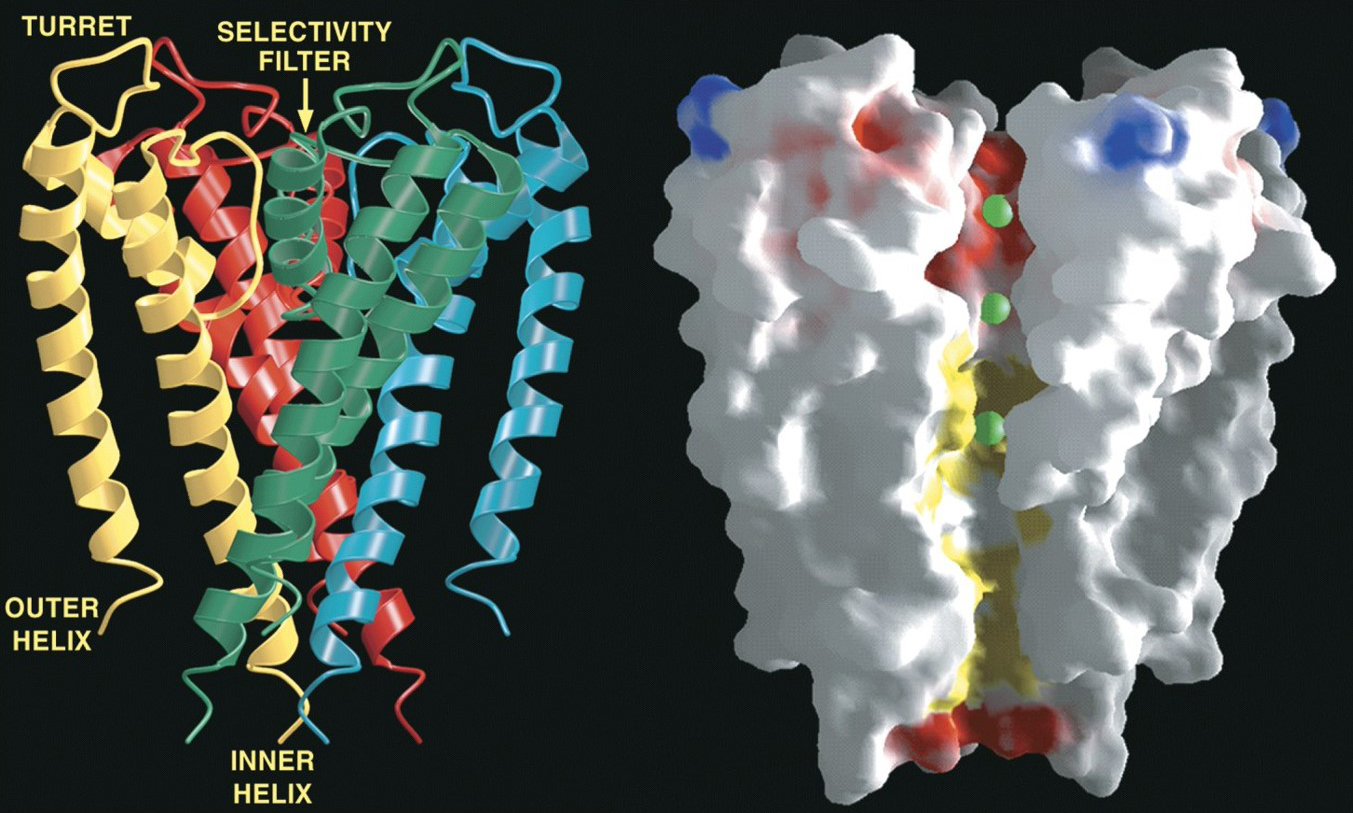
What is found at the entrance of the potassium channel and why is this significant?
Negatively charged amino acids to attract the positively charged K+ but repel anions
What enables the selectivity of the potassium channel towards K+?
The presence of a signature sequence TVGYG in the selectivity filter (top of the pore)
Provides the C=O groups of the backbone to coordinate “naked” K+ (w/o the hydration shell) )
What is the main function of ion channels?
To discharge ion gradients across membranes, which are established by ion pumps (active transporters)
How do ion channels prevent uncontrolled flux of ions through the channels?
Ion channels normally open and close transiently in response to a specific signal
What are the four types of ion channels?
Mechanosensitive channels
Ligand-gated channels
Signal-gated channels
Voltage-gated channels
What do mechanosensitive channels open in response to?
A physical stimulus causing local membrane deformation
What do ligand-gated channels open in response to?
A ligand bound from the outside of cells (e.g. neurotransmitter)
What do signal-gated channels open in response to?
An intracellular stimulus (e.g. Ca2+)
What do voltage-gated channels open in response to?
Changes in membrane potential (e.g. nerve impulses)
What are gap junctions and what do they form?
Tubular structure that are response for exchange of small molecules and ions between cells
They form intercellular channels
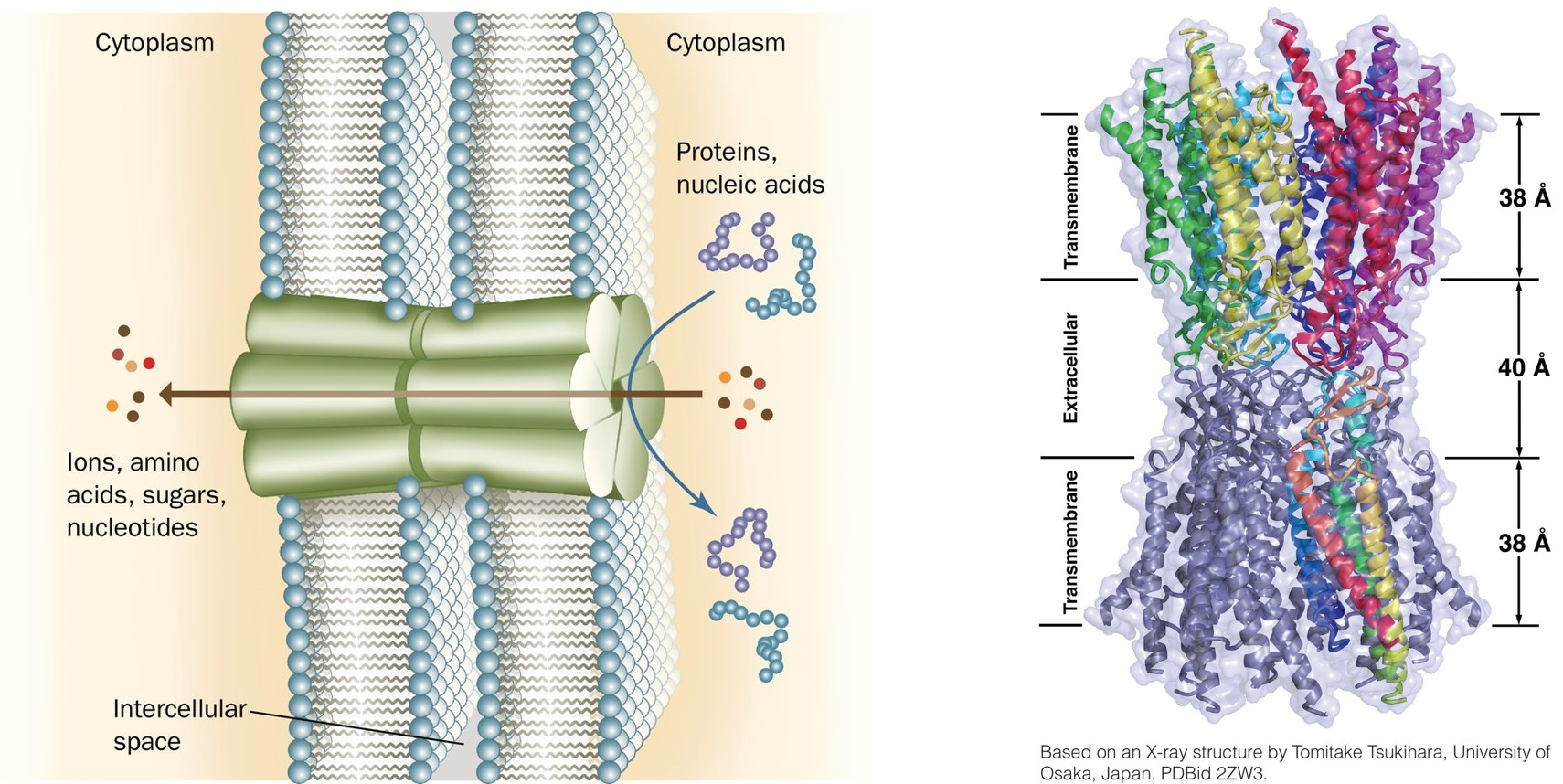
The intercellular channels of gap junctions do not allow what to pass through? What are these channels controlled by?
Biopolymers (e.g. nucleic acids or proteins)
Controlled by Ca2+ concentration
Gap junctions channels open and close with what concentrations of calcium?
Open at [Ca2+] less than 100 nM
Close at increase of [Ca2+] until it reaches ~0.5 nM
Based on the number of substances protein transporters move across membranes, as well as the mutual relation ship in the flow direction of each substance, protein transporters are classified as…
Uniports (one substance is translocated)
Symports (two substances are simultaneously transported in the same direction)
Antiports (two substances are simultaneously transported in the opposite direction)
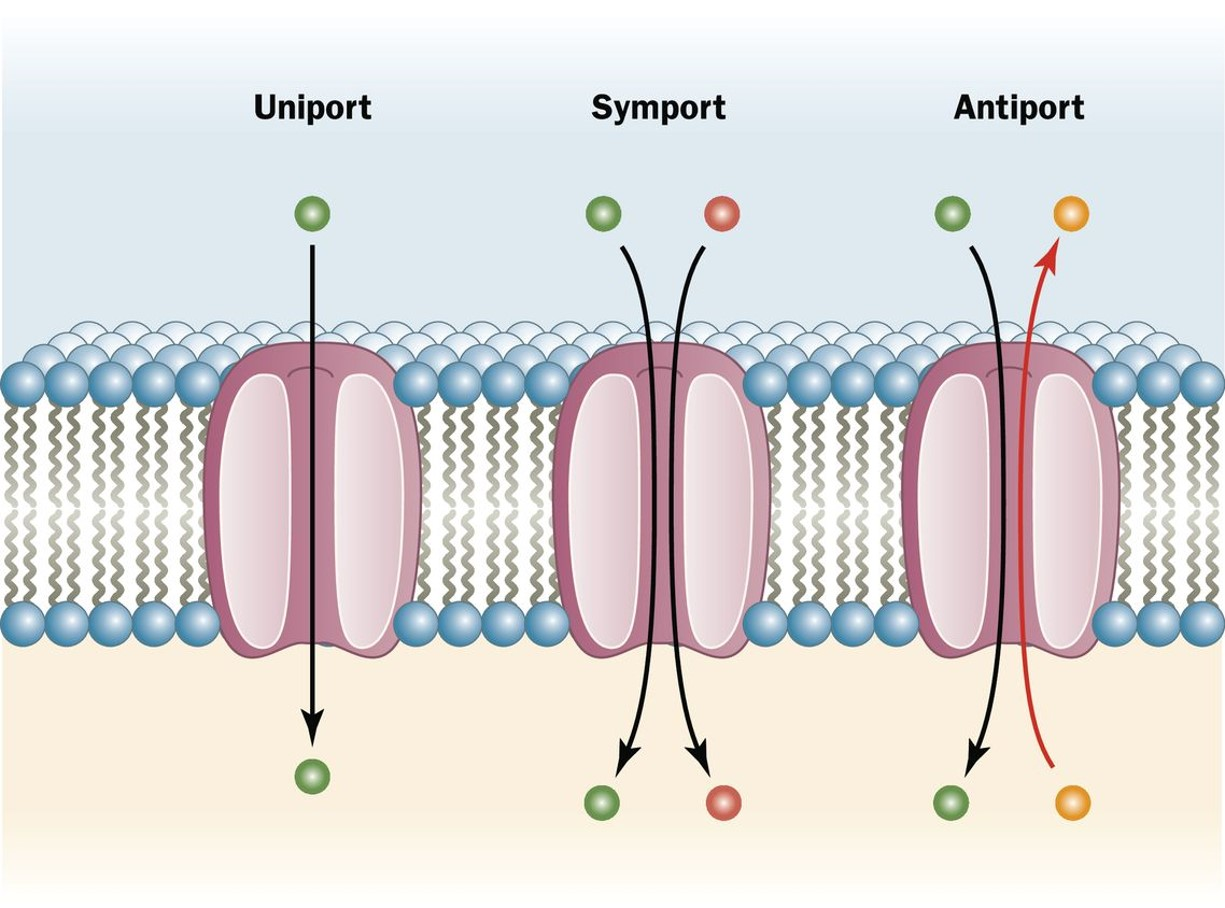
What are primary active transporters?
They pump molecules or ions against their concentration gradient by relying on hydrolysis of ATP
What are secondary active transporters?
They pump molecules or ions against their concentration gradient by using the energy of ion gradients as a driving force for the transport process
What are the several classes of primary active transporters and what do they transport?
P-type ATPases - Na+, K+, and Ca2+
F-type ATPases - Protons across the membranes of bacteria and mitochondria
V-type ATPases - Function in plant vacuoles and animal lysosomes; they resemble the F-type ATPases
A-type ATPases - Anions
ATP-binding cassette - transporters
Na+-K+ ATPase, also known as Na+/K+ pump, can be classified as an ___, and why?
Antiport
Pumps Na+ out of the cell and K+ into the cell
The ions are not simultaneously translocated though
How does the sodium-potassium pump work?
It uses the energy of ATP hydrolysis to translocate 3 sodium ions outside and 2 potassium ions inside the cell

Sodium ion concentration is greater ___ the cell, and potassium concentration is greater ___ the cell.
Outside; inside
Explain the conformational changes that take place in the sodium/potassium pumps.
The proteins undergo conformation changes from E1 to E2 conformational states in response to phosphorylation of its Asp residue to yield aspartyl phosphate
The phosphate group is donated by bound ATP
Phosphorylation occurs only when the protein has Na+ bound
Hydrolysis of the anhydride bond occurs only when K+ is bound inside the protein
How does Ca2+-ATPase work?
Pumps calcium ions out of the cytosol into the lumen of the sarcoplasmic reticulum

How is Ca2+-ATPase needed?
To maintain low concentration of Ca2+ inside the cell
What is the net equation of the transport process by Ca2+-ATPase.

Explain the conformational changes in Ca2+-ATPase
E1
Has the ion-binding sites exposed to the cytoplasm
Has high affinity to Ca2+
Binds ATO
P-type ATPase → undergoes transient phosphorylation by transferring a phosphate group from bound ATP to its amino acid residue

ABC transporters are responsible for…
Pumping small molecules including drugs out of either bacterial or eukaryotic cells (exporters, AKA effluxes)
Pumping nutrients into bacterial cells (importers)
How does lactose permease work?
Transports lactose into the cell using the energy of proton gradient established as a result of oxidative metabolism
What is the net equation for the translocation process for lactose permease?

Explain the conformational state changes in lactose permease?
E1
Low affinity to lactose
Lactose-binding site facing the interior of the cell
E2
High affinity to lactose
Lactose-binding site exposed to the periplasm
Conformational changes are triggered by lactose binding and protonation
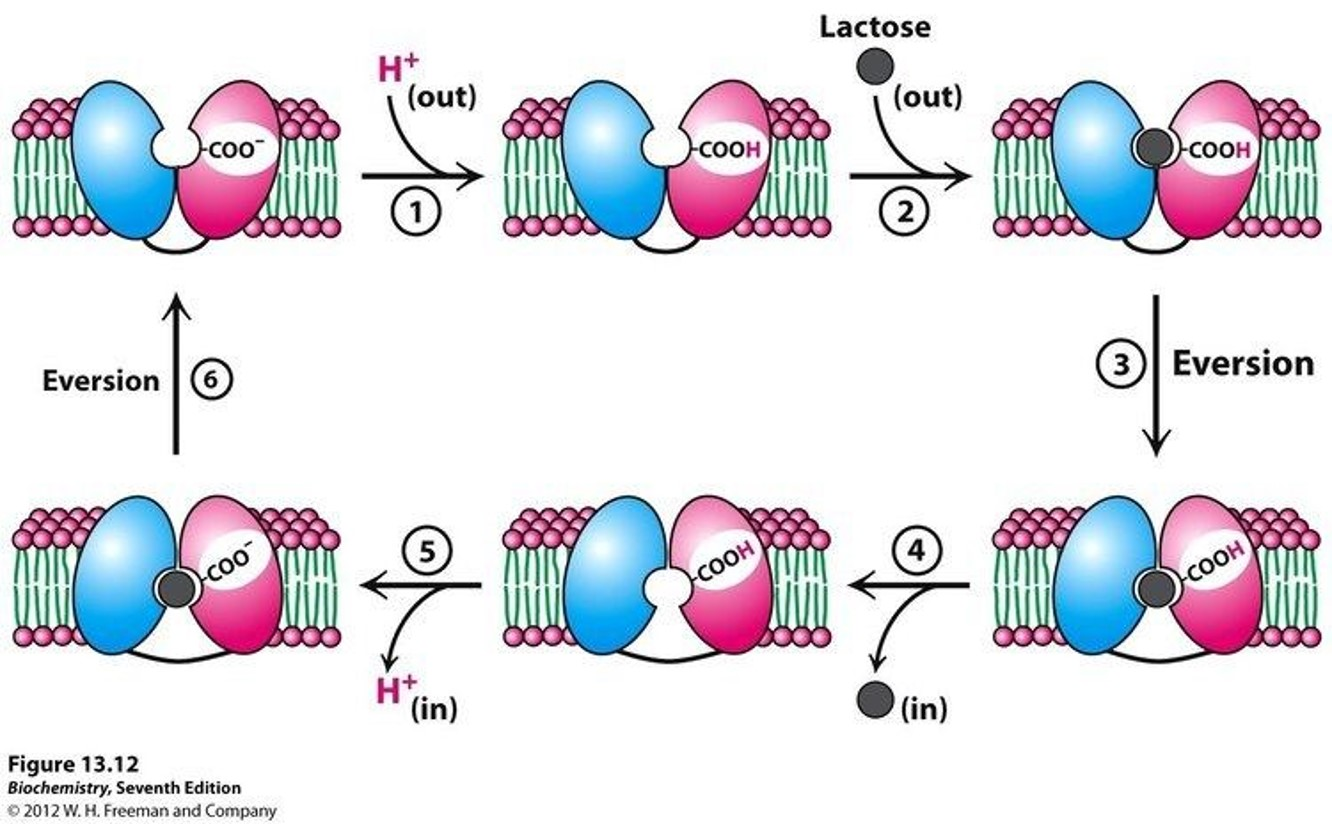
What is the driving force for glucose translocation?
The Na+ gradient, which is maintained by Na+/K+-ATPase
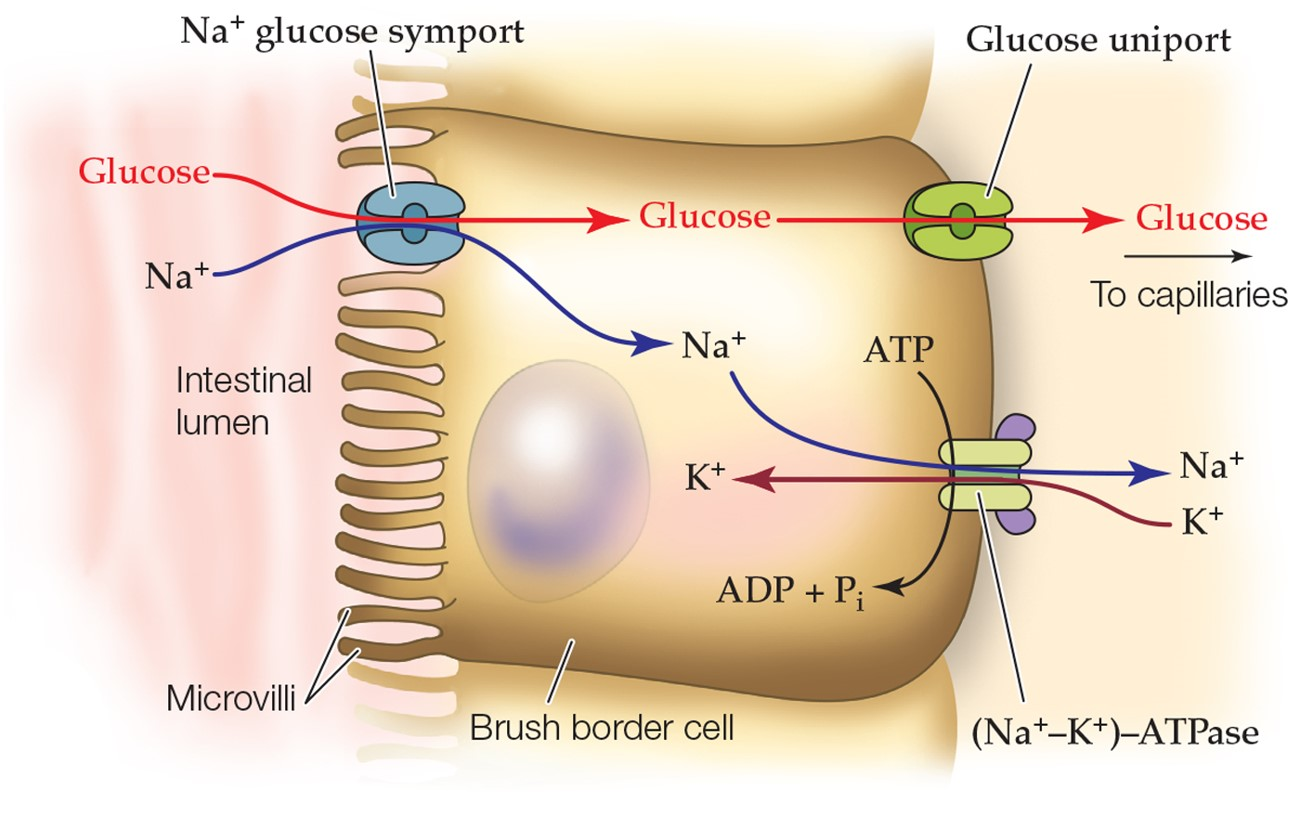
Free energy for translocating of an uncharged compound across a membrane depends on what?
The difference of the compound’s concentration between the compartments separated by the membrane

By analyzing this equation, we can see that the translocation process inside cells is…
Spontaneous ▲G < 0 if [C]in < [C]out
IF the compound is moving DOWN its concentration gradient
Free energy charge for ion translocation across biological membranes depends on both…
The difference between ion concentration across the membrane
The membrane potential
The charge of the translocated ion (z)

What equation is used to determine the fractional saturation of the transporter with the ligand?
